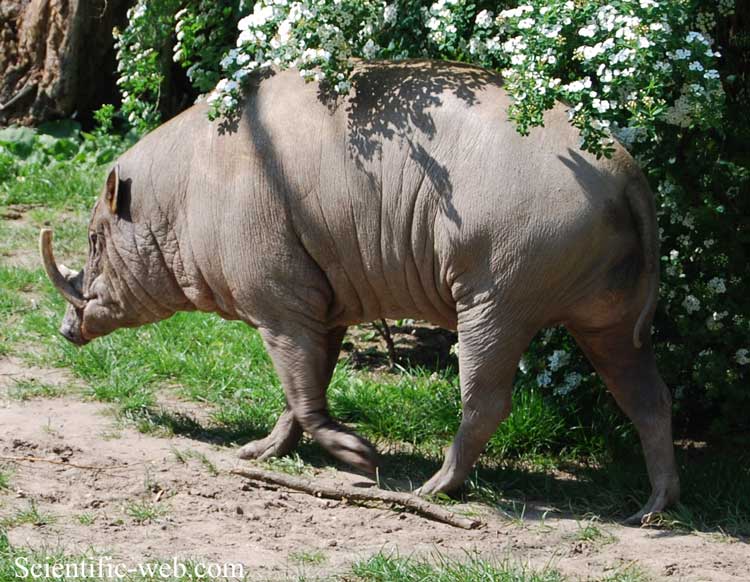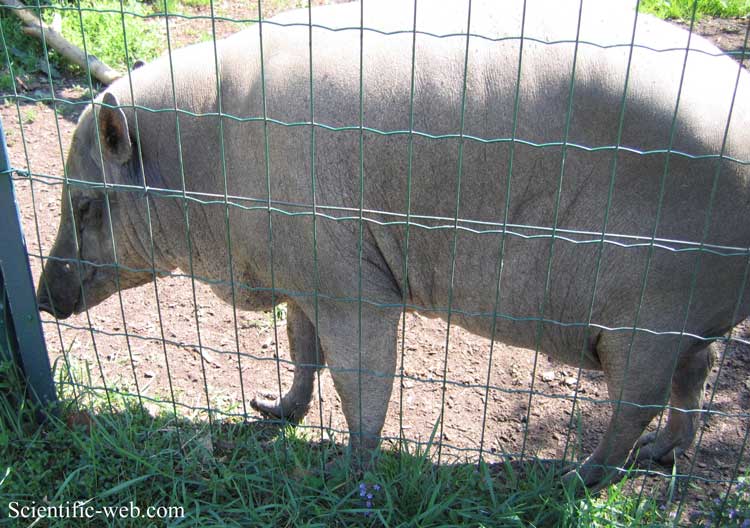
Babyrousa babyrussa, Photo: Michael Lahanas
Superregnum: Eukaryota
Cladus: Unikonta
Cladus: Opisthokonta
Cladus: Holozoa
Regnum: Animalia
Subregnum: Eumetazoa
Cladus: Bilateria
Cladus: Nephrozoa
Superphylum: Deuterostomia
Phylum: Chordata
Subphylum: Vertebrata
Infraphylum: Gnathostomata
Megaclassis: Osteichthyes
Cladus: Sarcopterygii
Cladus: Rhipidistia
Cladus: Tetrapodomorpha
Cladus: Eotetrapodiformes
Cladus: Elpistostegalia
Superclassis: Tetrapoda
Cladus: Reptiliomorpha
Cladus: Amniota
Cladus: Synapsida
Cladus: Eupelycosauria
Cladus: Sphenacodontia
Cladus: Sphenacodontoidea
Cladus: Therapsida
Cladus: Theriodontia
Subordo: Cynodontia
Infraordo: Eucynodontia
Cladus: Probainognathia
Cladus: Prozostrodontia
Cladus: Mammaliaformes
Classis: Mammalia
Subclassis: Trechnotheria
Infraclassis: Zatheria
Supercohors: Theria
Cohors: Eutheria
Infraclassis: Placentalia
Cladus: Boreoeutheria
Superordo: Laurasiatheria
Cladus: Euungulata
Ordo: Artiodactyla
Cladus: Artiofabula
Subordo: Suina
Familia: Suidae
Genus: Babyrousa
Species: Babyrousa babyrussa
Synonyms (5): B. alfura – B. beruensis – B. frosti – B. indica – B. orientalis – B. quadricornua
Name
Babyrousa babyrussa (Linnaeus, 1758)
Original combination: Sus babyrussa
Type locality: 'Borneo' [recte: Buru]

Babyrousa babyrussa, Photo: Michael Lahanas
References
Primary references
Linnaeus, C. 1758. Systema Naturae per regna tria naturæ, secundum classes, ordines, genera, species, cum characteribus, differentiis, synonymis, locis, Tomus I. Editio decima, reformata. Holmiæ: impensis direct. Laurentii Salvii. i–ii, 1–824 pp DOI: 10.5962/bhl.title.542: 50. Reference page.
Links
Babyrousa babyrussa in Mammal Species of the World.
Wilson, Don E. & Reeder, DeeAnn M. (Editors) 2005. Mammal Species of the World – A Taxonomic and Geographic Reference. Third edition. ISBN 0-8018-8221-4.
Vernacular names
brezhoneg: Babirousa blevek
català: Babirussa de Buru
čeština: Babirusa
Deutsch: Molukken-Hirscheber
English: Buru Babirusa
Esperanto: Babiruso
español: Babirusa
suomi: Hirvisika
français: Babiroussa
galego: Babirusa
עברית: בבירוסה
magyar: Babirussza
Bahasa Indonesia: Babirusa
Ido: Babiruso
italiano: Babirussa
日本語: バビルサ
ქართული: ბაბირუსა
한국어: 바비루사
lietuvių: Babirusa
Nederlands: Gouden babiroessa
norsk: Vanlig hjortesvin
polski: Babirussa
português: Babirusa
русский: Бабирусса
српски / srpski: Бабируса
svenska: Hjortsvin
українська: Бабіруса
Tiếng Việt: Lợn hươu
中文: 鹿豚
The Buru babirusa (Babyrousa babyrussa) is a wild pig-like animal native to the Indonesian islands of Buru, the two Sula Islands of Mangole and Taliabu. It is also known as the Moluccan babirusa, golden babirusa or hairy babirusa. Traditionally, this relatively small species included the other babirusas as subspecies, but it has been recommended treating them as separate species based on differences in their morphology.[2] As also suggested by its alternative common names, the Buru babirusa has relatively long thick, gold-brown body-hair – a feature not shared by the other extant babirusas.[3][4]
In absence of detailed data on the Buru babirusa, it is generally assumed that its habitat and ecology are similar to that of North Sulawesi babirusa (B. celebensis). Furthermore, as all babirusas were considered conspecific under the scientific name B. babyrussa until 2001, data collected before that is consistently listed under the name B. babyrussa, though the vast majority actually refers to B. celebensis (by far the best known species of babirusa). Babirusas tend to occupy tropical rainforests, river banks and various natural ponds rich in water plants. They are omnivorous and feed on various leaves, roots, fruits, invertebrates and small vertebrates. Their jaws and teeth are strong enough to crack any kind of nuts. Babirusas lack the rostral bone in their nose, which is a tool used by other wild pigs for digging. Therefore, they prefer feeding on roots in soft muddy or sandy soils. Cannibalism was reported among babirusas, feeding on the young of their own species or other mammals.[5] North Sulawesi babirusas form groups with up to a dozen of individuals, especially when raising their young. Older males might live individually.[2]
The north Sulawesi babirusa reach sexual maturity when they are 5–10 months old. Their estrous cycle is 28–42 days, and the gestation period lasts 150–157 days. The females have two rows of teats and will give birth to 1–2 piglets weighing 380–1050 grams and measuring 15–20 cm, which they will nurse until the age of 6–8 months. The lifespan is about 24 years.[6][5]
The Buru babirusa has been assessed as vulnerable on the IUCN Red List, as its habitat is restricted a total area of 20,000 km2 (7,700 sq mi), and its gradual loss due to logging. Hunting by the local population is another cause of concern. Whereas it is unpopular among Muslim communities for religious reasons, it is widely hunted by the indigenous people of Buru, which are predominantly Christian. The meat of the Buru babirusa has low fat (only 1.27% compared to 5–15% for domestic pigs) and is regarded as a delicacy. It is also preferred by the locals to the meat of other wild pigs or deer in terms of texture and flavor.[2] The establishment of two protected areas on Buru, Gunung Kapalat Mada (1,380 km²) and Waeapo (50 km²), partly aim at preserving the habitat of the Buru babirusa.[7] This species also enjoys full protection under Indonesian law since 1931.[2]
References
Grubb, P. (2005). "Species Babyrousa babyrussa". In Wilson, D. E.; Reeder, D. M. (eds.). Mammal Species of the World: A Taxonomic and Geographic Reference (3 ed.). Baltimore, MD: Johns Hopkins University Press. p. 637. ISBN 0-8018-8221-4. OCLC 62265494.
Macdonald, A.A.; Burton, J. & Leus, K. (2008). "Babyrousa babyrussa". IUCN Red List of Threatened Species. 2008: e.T2461A9441445. doi:10.2305/IUCN.UK.2008.RLTS.T2461A9441445.en. Retrieved 16 January 2022.
Meijaard, E. & Groves, C. P. (2002). "Upgrading three subspecies of Babirusa (Babyrousa sp.) to full species level". IUCN/SSC Pigs, Peccaries, and Hippos Specialist Group (PPHSG) Newsletter. 2 (2): 33–39.
Meijaard, E.; d'Huart, J. P. & Oliver, W. L. R. (2011). "Babirusa (Babyrousa)". In Wilson, D. E. & Mittermeier, R. A. (eds.). Handbook of the Mammals of the World. Vol. 2. Hoofed Mammals. pp. 274–276. ISBN 978-84-96553-77-4.
Priosoeryanto, B. P. (2007). "Empowering of Society through the Animal Health and Production Activities with the Appreciation to the Indigenous Knowledge". Proceedings of the Mini Workshop Southeast Asia Germany Alumni Network (SEAG), 3–5 May, Manado, Indonesia. pp. 83–92. ISBN 978-3-89958-389-2.
Douglass Hayssen, V.; Van Tienhoven, A. & Van Tienhoven, A. A. (1993). "Order Artiodctyla, Family Suidae". Asdell's patterns of mammalian reproduction: a compendium of species-specific data. Ithaca and New York: Cornell University Press. pp. 377–380. ISBN 0-8014-1753-8.
"Buru rain forests". Terrestrial Ecoregions. World Wildlife Fund.
Retrieved from "http://en.wikipedia.org/"
All text is available under the terms of the GNU Free Documentation License

